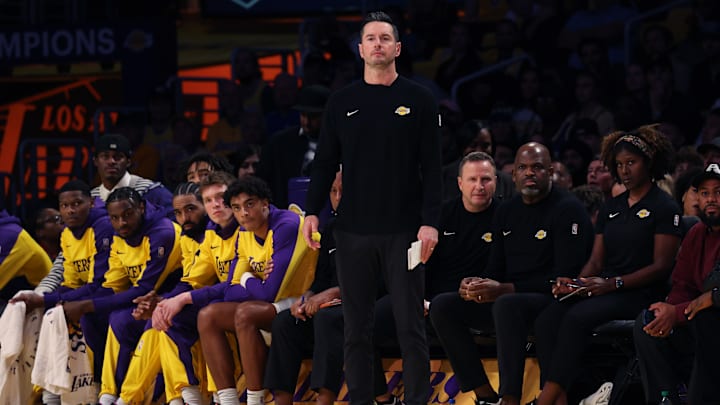The Los Angeles Lakers are off to a better start than anyone could've imagined. Matched up against three postseason-caliber teams during the first week of the 2024-25 regular season, Los Angeles walked away with three consecutive victories.
That includes an early back-to-back during the second and third games of the season, which first-year head coach JJ Redick navigated to virtual perfection.
Redick and the Lakers began the season with a 110-103 victory over the Minnesota Timberwolves that largely centered around Anthony Davis and Rui Hachimura leading by example. The next time out, it was Davis and Austin Reaves who set the tone in a 123-116 win over the Phoenix Suns.
The very next night, during the first back-to-back of Redick's coaching career, Los Angeles overcame early smothering defense as Davis and LeBron James led the team to a 131-127 win over the Sacramento Kings.
Three games, three wins—each with a different co-star taking center stage alongside Davis. Beyond that obvious reality, however, was a clear and fundamental difference to be found in the way the team played from the first two games of the season to the second leg of the back-to-back.
In turn, a simple question faces the Lakers' first-year head coach: Is this formula sustainable?
Can the Lakers really win consistently with their current formula?
The first three games of the season only count for so much, as every team is still figuring out who and what they plan to be. The game against the Kings was noticeably different from the first two outings, however, with the primary change being the general approach to offense.
While the first two games were won due in no small part to constant off-ball action and key contributions from the role players, the third was more of a stationary effort.
James took over for the first time this season, with the ball often finding his hands and teammates seemingly waiting for his instructions. The off-ball motion ground to a virtual halt, and James instead directed traffic in more of an ISO-based role that sent one Laker to the place he wanted them to be rather than a full five-man involvement.
The end result was worth it in the end, as James turned in a throwback performance with 32 points, 14 rebounds, and 10 assists, including a full takeover during the fourth quarter.
Despite the Lakers scoring 64 points in the first half and 131 overall, however, one can't help but notice the red flag. Los Angeles’ free-flowing offense got everyone involved and created a more energetic attack than what the team put forth against Sacramento.
It's a difficult point to sell considering the Lakers produced their highest-scoring outburst of the season, but the formula that got them there was at least somewhat based on good fortune.
The Lakers won't often be able to commit 19 turnovers, let alone allow 127 points, and still come away with the win. Los Angeles will also have very few fourth quarters during which it shoots 13-of-17 from the field—translating to an absurd 76.5 percent.
The question that can be posed in response to those concerns, however, is equally as compelling: Shouldn't the Lakers be encouraged by the result?
On the other hand...
The crucial context includes the fact that this was the second leg of the first back-to-back of the season. Los Angeles had never been in this type of situation with Redick as head coach, and James took it upon himself to alleviate some of the burden from the first-year sideline general.
That's a positive that could indicate Redick and the Lakers' luxury of being able to learn on the fly due to James' presence as a world-class leader on the court.
Mike Brown also brilliantly had his team playing physical on-ball defense from the millisecond after the opening tip. That stifled the Lakers' off-ball action early and inevitably resulted in ball-handlers needing to create their own offense to break the opposition's hold on them.
Yes, the Lakers seemed to move more without the ball when James wasn't on the court, but they also would've lost this game had he not taken over.
There may also be a strategic reason for the approach that differed from the Kings game as opposed to the bouts with the Suns and Timberwolves. James attempted a combined 29 field goals during the first two games of the season, and put up 22—plus four free throws—against the Kings.
Redick may have devised a strategy that will see James in a less prominent role leading up to a back-to-back to preserve his energy so the 39-year-old can guide the team through the second leg while Davis takes the lead during the first.
It's also within the realm of possibility that the Lakers' starters were simply fatigued after playing three games in five days to open the season. James may have taken note of this and decided to embrace the burden of the leading role on offense while Davis battled All-NBA matchup Domantas Sabonis.
Regardless of what the accurate explanation is, one thing is clear: Redick cracked the back-to-back code on his very first try.
The question facing the Lakers moving forward is simple: Is the current formula sustainable or was James just uniquely otherworldly for one night in Los Angeles?
